Mon 30 Apr 2012
A TV Series Review by Michael Shonk: SHOTGUN SLADE (1959-61).
Posted by Steve under Reviews , TV Westerns[20] Comments
SHOTGUN SLADE. Revue Studios/MCA TV. Syndicated, 1959-61, 78 episodes. Created by Frank Gruber. Executive Producer: Nat Holt. Cast: Scott Brady as “Shotgun†Slade.
“Shotgun†Slade (his first name was never mentioned) was the lone member of the Slade Detective Agency, with his office in Denver. He traveled all over the Old West for clients who had hired him.
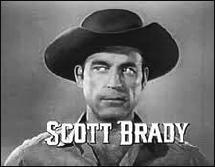
Scott Brady (He Walked by Night) was convincing as a tough Western PI who could handle himself in a fight, but less convincing as Slade the ladies man. Oddly, while he had a beautiful woman waiting for him in virtually every town, Slade thought of himself as a loner.
It was 1959, the PI was beginning to replace the Western on TV, this gimmick heavy syndicated TV series wanted it both ways. Creator Frank Gruber is a familiar name to Pulp and Westerns fans alike. Gruber had worked with Executive Producer Nat Holt on several B-Westerns including The Great Missouri Raid, as well as the TV series Tales of Wells Fargo. Holt is also remembered for his movie work with Randolph Scott (Rage at Dawn). At one point Ralph Dietrich, whose producer credits include a couple of Charlie Chan films, took over as producer from Gruber.
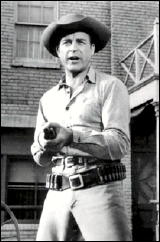
The series was typical of 50s TV-Film syndication. Stories required a least one fight and, as often as possible, for Slade to be knocked out from behind so he could wake up in the care of the beautiful woman of the week.
Slade would narrate over scenes to give exposition so not to slow down the action in this time limited thirty minute PI/Western. The mysteries offered few clues and suspects, but focused on twist after twist until the villain was revealed.
While the locations were pure Western, the stories were more noir PI than the morality plays of TV Westerns. In “Golden Tunnel,†Slade’s old friend and owner of a mine called Slade for help. He was seventy years old and had a young wife he trusted (and shouldn’t) and a nephew he trusted (and shouldn’t) helping him run the place.
There were problems at his mine, someone had taken a shot at him, and, oh by the way, he just discovered the son he thought dead was alive and wanted Slade to make sure his new Will gets to the probate court when he dies, which he does in the next scene.
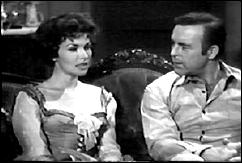
Throughout the series the guest cast was filled with character actors (Alan Hale, Stacy Keach), B-movie favorites (Marie Windsor), and an occasional surprise (Ernie Kovacs).
There is a reason so much of TV-Film syndication from the 50s and 60s look alike. In Storytellers to the Nation: A History of American Television, by Tom Stempel (First Syracuse University Press, 1996), D.C. Fontana (Star Trek) discussed the limitations imposed on writers of half hour TV film syndicated shows established by Ziv and followed by Revue (Universal).
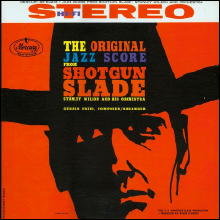
There were countless Westerns and PI shows on the air in 1959. Every series needed something to stand out from the crowd. Shotgun Slade had two obvious gimmicks.
First was his weapon, a gun he had made himself, with a rifle barrel atop a double barrel shotgun. While it had its uses, such as using the barrel to knock the handgun out of the bad guy’s hand, it looked awkward as Slade carried it everywhere he went.
The other gimmick was the jazz soundtrack by Gerald Fried (The Killing). The idea of using jazz music as the soundtrack for a show set in the “Old West†was an interesting but doomed experiment. It proved that no matter how popular the music is at the time of the viewers, the music needs to fit the time of the characters.
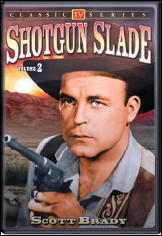
A review in Billboard (8/22/60) gave the soundtrack album (The Original Jazz Score from Shotgun Slade, by Stanley Wilson and his Orchestra; Mercury Records) three out of four stars and said, “…Altho the TV show is a Western, the music is much more closely allied to current ‘private eye’ type, jazz-oriented music than to the old-fashioned Western ditties. It makes for good listening tho it doesn’t have the same melodic appeal of the Mr. Lucky or the Peter Gunn material.â€
Words can not come close to properly describing this song, from an episode of Shotgun Slade, sung by Monica Lewis. (Follow the link.)
Shotgun Slade gave Oscar winning director Sydney Pollack (Out of Africa) his first director job. In The Directors: Take One, Volume One, by Robert J. Emery (Allworth Press 2002), Pollack explained how he got his chance when Shotgun Slade had been cancelled but had a few episodes left to film so they gave him a chance to learn on the job.
The series was popular and, according to Broadcasting (May 30, 1960), it was syndicated in 170 markets. But if you expect Peter Gunn on horseback, you will be disappointed. It had some interesting talent in front and behind the camera, and tried new things with music and drama, but in the end Shotgun Slade offers little (beyond what not to do) worth remembering.
Episodes of Shotgun Slade are available from various DVD sellers and all over the Internet from archives.org to YouTube.

April 30th, 2012 at 7:26 pm
The term B film is thrown around without clarity, so here goes. There are two significant elements that define a B. The first is budget, the second is in distribution. Generally speaking $350,000 is the dividing line, but far more importantly is whether the exhibitor pays via a percentage of the box office take, or on a fixed rental basis. The Nat Holt films described in this piece may very well be unimportant, except of course to the participants, but they are not B’s. Not presented or produced as such. The Autry, Hoppy, Rogers, Durango Kid films, and others, were pretty much B pictures, although quite a few of the Autry specials were sold a little differently, as were a few Rogers pictures. The Randy Scott – Budd Boetticher pictures are often referred to a B films. Strictly speaking, that’s not so. They were, however second features. Not the same thing.
April 30th, 2012 at 9:06 pm
Barry, you are right. Like most labels they can acquire a broader use but not a correct one, I should have left the B off the Western for GREAT MISSOURI RAID.
April 30th, 2012 at 9:28 pm
Thanks for your comment, Barry. I think the concept of a B-movie has been altered and distilled down enough so all it means to most people today is a “cheaply made film.” I’m sure I’ve been guilty myself of using the term in regard to movies that I shouldn’t have. It’s just too easy to concentrate on the “budget” aspect.
There is a great book titled “B” movies: An informal survey of the American low-budget film, 1933-1945, by Don Miller (Curtis, paperback, 1973) that I practically wore out when it first came out. (But once again, note the emphasis on “low budget.”)
I don’t remember if he used the correct definition of B-movies in the book itself, but what made it such a treasure back then was that the movies covered in it were the movies I remembered growing up with. What I wished for, more than anything else, was that I could actually see the movies Miller was writing about, never dreaming the day would come when tons and tons of them would be available again, mostly bootleg DVDs but some with official releases, and all easily obtainable.
Getting back to SHOTGUN SLADE, though, there is an online seller who’s offering 61 of the 78 episodes for sale on DVD. Since he’s asking only $24.95, you have to wonder how many shows he’s crammed onto how many cheap disks, but at least they do exist. I have I think a dozen myself from Oldies.com, but so far I haven’t gotten around to watching them. They sound like fun, but I’m sure there’s no way I could watch 78 (or even 61) of them all in a row.
April 30th, 2012 at 11:18 pm
Michael:
Thank you for being so gracious.
Steve:
I’ve seen so many film labels abused, and that followed by misinformation, that I just decided to tilt at windmills. Too often a film that someone doesn’t like, or feels is unimportant thematically, is dismissed as a B. Words and labels have meanings, although they may be multiple, and I believe we should try to keep records straight as much as possible. I think the internet with all its strengths is partly to blame.
May 1st, 2012 at 2:02 am
Never was ANYone wooed by such a song as that, indeed. I think there’s a reason that after being up for about 8 months that fewer than a hundred people have subjected themselves to that clip.
May 1st, 2012 at 6:40 am
Geting back to SHOTGUN SLADE, I wonder if the character had any relationship to the “Slade” whose career and demise are recounted by Mark Twain in ROUGHING IT.
Scott Brady was an interesting actor of limited resources who showed up best as The Dancin’ Kid in JOHNNY GUITAR
Frank Gruber ws a hack who did his best work in the movies, including a few “Sherlock Holmes” flicks and the skillful screenplay of MASK OF DIMITRIOS whe he managed not to run a fine story.
May 1st, 2012 at 6:58 am
Steve, I feel the same about Don Miller’s “B” Movies book. I literally wore mine out and recently was able to pick up a replacement copy.
May 1st, 2012 at 8:28 am
The comments about jazz tracks made me think of the Clint Eastwood film JOE KIDD (1972), which has a jazzy score by Lalo Schifrin. It makes for an unusual and, in this case, ironic effect.
May 1st, 2012 at 8:47 am
From what I read this show was originally packaged by MCA for NBC, which passed. Kovacs wasn’t the only anomalous guest star: others included football player Elroy “Crazylegs” Hirsch, WWII flying ace Gregory “Pappy” Boyington (the Robert Conrad character in Baa Baaa Black Sheep), Johnny Cash, and Tex Ritter. Supposedly Brady was a huge sports fan who dreamed of having Yogi Berra on, but alas, some dreams are not meant to be. This mash-up of western and P.I. conventions to accommodate changing genre tastes reminds me of what happened in 1965 with another Robert Conrad show — The Wild Wild West — which combined the fading western with the James Bond-inspired spy craze.
May 1st, 2012 at 11:34 am
#6 Dan. I don’t think so. I have not read ROUGHING IT but have skimmed through the pages. He seems too “legendary.”
Shotgun was just a stock character PI, a loner, with few friends and fewer who knew him – unless you were female. He often fought and was more likely to use his gun to disarm the bad guy than shoot him.
The character drifted into whatever the story needed. Some episodes had women swoon at the sight of him, some episodes had women all ready spoken for but attracted to him, some had old girlfriends longing to have him settle down with them. He was a loner with no friends then works for one of his best friends.
You know Twain’s Slade better, does that sound like him?
May 1st, 2012 at 11:49 am
#8. Ron, Schifrin’s JOE KIDD maintained the epic sense of a Western. His choice of instruments such as the guitar had a “Western” feel, while Fried’s use of jazz leaned more towards “Big Band” and PI stories but felt out of place with what we were seeing.
May 1st, 2012 at 11:59 am
#9. David, Ernie Kovacs was a talented dramatic actor. In a part that most actors would have turned widely comedic, he pulled it back and played it straight.
His episode “Salted Mine” can be viewed in two parts on YouTube.
Part One:
https://www.youtube.com/watch?v=g8Xv7XYPFFg
And to be reminded Kovacs was one of the funniest visual comedians ever to work in television, another clip from YouTube
https://www.youtube.com/watch?v=ZEEhtKdUEtU
May 1st, 2012 at 12:20 pm
In the book WESTERN WOMEN: INTERVIEWS WITH 50 LEADING LADIES OF MOVIE AND TELEVISION WESTERNS FROM THE 1930’S TO THE 1960’S (McFarland) by Boyd Magers and Michael G. Fitzgerald, Paula Raymond (THE TALL TARGET) told about her experience with Scott Brady and SHOTGUN SLADE.
She had dated Brady. “Once he had me backed up to the kitchen sink, trying to get a little sex – my mother was upstairs. I got away and never went with him again.”
“Then we did SHOTGUN SLADE. Scott liked to embarrass ladies. There’s a scene where he’s lying in bed-wounded. Next to him was this hurricane lamp. He took the spoke off the lamp and put it under the cover-just to embarrass me. I ignored it. He chuckled to himself. The crew knew me from other things- they knew I was ladylike.”
Brady was late and holding up shooting. As he finally arrived, he “put his hand down his pants, pretending to fix his shirt. I said, ‘Don’t worry fellows, he’s just trying to see if it’s still there.’ Well, they started howling, and this delayed production even more! It seemed all the more funny coming from the mouth of a lady.”
May 1st, 2012 at 12:49 pm
Michael
If I can find an expensive copy of WESTERN WOMEN, I’ll have to buy a copy. Thanks for retelling those stories.
It is, by the way, Paula Raymond who is sitting next to Brady in that back and white photo I found online and used to illustrate this article of yours.
Most of her early movie roles were uncredited ones, but in the 50s her name showed up on the screen much more often. Besides THE TALL TARGET, she was also in THE BEAST FROM 20,000 FATHOMS.
But most of her career was spent on TV, where according to the Trivia note on her IMDB page, she is of note for having turned down the role of Kitty on GUNSMOKE. She was also Margot Lane in the 1954 pilot for THE SHADOW.
Pulp fans might also like to know that her grandfather was Farnsworth Wright, the editor of WEIRD TALES from 1924 until his death in 1940.
Forgive me for going on like this, on what is really quite a tangent. When I can suddenly put a name to a face I’ve seen many times before, I tend to do that.
May 1st, 2012 at 1:25 pm
Steve, you can read parts of WESTERNS WOMEN at google books for free. When you search be sure to include the s at the end of ‘Westerns.”
May 1st, 2012 at 1:45 pm
Way back in 9. David mentioned WILD WILD WEST mixing Westerns and spies. Mixing genres can work such as HAVE GUN WILL TRAVEL where the troubleshooter out West worked well.
The central problem with SLADE was it was badly done. The character had an office in Denver, then he is traveling alone in the country. He was a loner, then had friends he did favors for. Cheaply produced, limited in what they could do visually and dramatically, music that fit the story but not the picture, and a sense this is television and it doesn’t matter; all doomed this series.
It is, much like TV-Film syndicated series of the era, a nice way to kill thirty minutes if you don’t expect much.
The show was popular and had tie-in toys such as a Shotgun Slade toy gun. So I expect much of the audience were young boys.
May 1st, 2012 at 3:13 pm
I’m a bit surprised that so far nobody has mentioned that Scott Brady was the younger brother of the beloved/notorious Lawrence Tierney, much thought of in these precincts.
In his later years, Brady, bulked up and balding, played tough bosses/cops/officers all over TV; one of his last roles was as Shirley’s father on Laverne & Shirley.
He also had a recurring role on Police Story as the ex-cop owner of a cop bar.
Scott Brady’s death had a strange after-effect: reviving his brother Lawrence Tierney’s acting career. The older tough-guy roles were still being written, and now the even balder and bulkier Tierney was playing them.
I still have my copy of Don Miller’s B Movies book, or at least its component parts. The hardest part is keeping all those loose pages in order. I have similar problems with other Curtis paperbacks from the same period – Leonard Maltin’s Laurel & Hardy Book is on its last leaves as well.
May 1st, 2012 at 3:40 pm
Mike Doran, Brady had a busy career guest starring on a variety of TV series, while I think of Tierney more from his movie days. I always found more personality to Tierney than Brady, who (probably unfairly) struck me as someone waiting for his paycheck.
May 2nd, 2012 at 7:35 am
Not to discount any of his earlier work, but to me Lawrence Tierney will always be remembered as Joe Cabot in Reservoir Dogs and as Frankie Balls in the late, great EZ Streets.
December 29th, 2018 at 12:08 am
Hi Michael,
I don’t know if anyone has been recently reading this article or not, but in my online research about Shotgun Slade I happened to run across this
particular one and found it interesting as the show was way before my time of course. However, being interested in classic TV Western series specifically the 50’s decade, it should be noted that the 1959-1960 season on TV was filled with no less than 32 Western shows. Whether that included both what were then the three major networks (prime-time) and syndicated series
(which Shotgun Slade was) I would assume that
would be the case.
In recent years I have acquired one of those 61 episode sets of the series from the collectors market and in going back to watch them despite
the quality (16 mm. film prints) the show as a whole was really not that bad at least compared
to current offerings on network and cable TV in
my opinion. As for the quality of the recordings, they have their share of problems, tape wear issues (being VHS), too dark pictures
to be able to actually see what’s going on in certain night time scenes but not in all 61 episodes, and at least one (Season 2 # 40
Skyfire) is too bright to also be seen (just
the opposite of the too dark issue). They would fall in the category of what I like to call, watchable/better than nothing. And considering that the series today has been virtually forgotten as has been previously stated, those
who like it can consider themselves fortunate that it’s even still available and yes, in this form despite being “bootlegged”. Since the original studio Revue (later Universal Television) did not see fit to do anything with the 79 episodes after syndication and reruns, it has fallen into public domain. Obviously the original film prints have long since been done away with if the 50’s version of Dragnet is any indication (the 276 episodes presumably lost by Universal as nobody there even knows where they are at present). The late video company Timeless Media Group since acquired by Shout Factory might have eventually gotten around to releasing Shotgun Slade on DVD (perhaps incomplete) since other such rare obscure
Universal/Revue properties did get released but Shout Factory does not appear to be all that interested in TV Westerns as TMG once was.
As as it is, there are some independent
companies with retail sets commercially produced (which I also have) but they appear to contain the same exact episodes (Echo Bridge, Alpha Video, etc.) and Timeless did release a 2 set
10 episode version in the late 2000’s but they cut off the opening credits of the series in favor of including them at the beginning of the main menu. At my count, a grand total of 18 episodes (of the 79, not 78 according to epguides.com’s episode title list and the book TV Westerns Episode Guide) are unaccounted for;
3 from Season 1 and 15 from Season 2, at least
in the collectors sets I have found some of which are repeated in the commercial public domain sets. I’m afraid at this point this is the best interested parties are going to get at least on DVD. From what I understand and have heard through various sources, a lot of film prints of TV series in general have been either been lost or destroyed (having been left neglected by studios in the vaults, the 2008
Universal film vault fire a case in point) and the powers-that-be in charge have no interest or inclination in preserving them or converting them to digital TV or restoring them for official DVD release. We fans and collectors are therefore very lucky what has been released by the studios has actually been released since the DVD format came into existence. But on the other hand, many TV series that didn’t make it will sadly never ever be seen again anywhere, except
maybe in the collectors market from TV airings or film prints, and that alas is it.
A little trivia: the late singer-actress Monica Lewis sang a shorter vocal version of the theme song at the beginning of episode 3 Lady And The Piano (and not seen thereafter in it) as well as during the end credits of the episode in question. In her biography on Wikipedia and her obituary the fact that she sang a vocal version of the theme song for Shotgun Slade was not mentioned at all. Also the first 2 episodes of the show did not start with the later jazz theme song that came later. There was an alternate more ominous instrumental theme song (which can be heard at the end of episode 2 Salted Mine guest starring the late comedian Ernie Kovacs if anyone’s interested) but it was quickly dropped
and replaced with the jazz version starting at episode 3 although one copy of the pilot episode The Missing Train (of the series) have the jazz theme included in the opening “Slade shoots his shotgun” sequence as opposed to the opening (in episode 2) with the ominous sounding theme song.
Just some observations from someone who cares. 🙂 Thanks for reading. It’s appreciated.